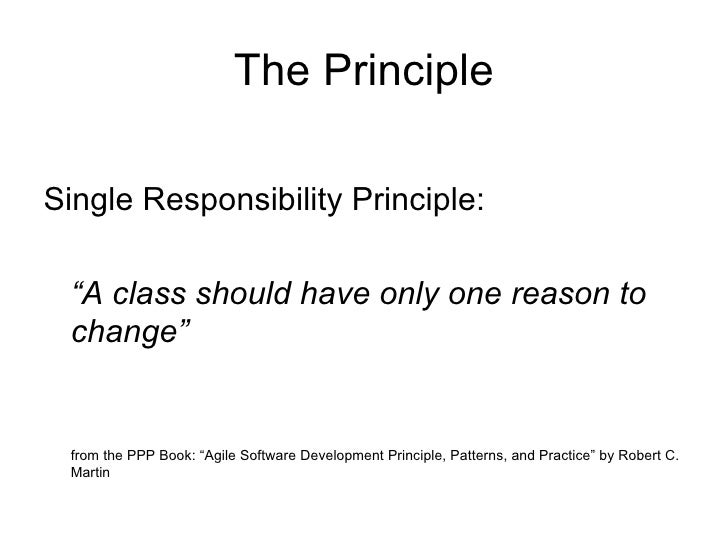
In this case, you don’t have to worry about too much.

So to create this plugin, you need to think about the tasks your plugin needs to do.
Single responsibility principle. code#
You can find the complete code on GitHub. I am a big meme fan so we will creating a small WP Meme Shortcode plugin as an example. Let’s help you use the single responsibility principle to build a WordPress plugin. Now that we covered some initial bases, let’s get into the meat of this. Let’s apply the Single Responsibility Principle Your class has no purpose because it does everything. It also doesn’t follow the single responsibility principle. It leaves you with an enormous class containing all your functions.ĭoing things this way doesn’t offer you any advantages over just using a function prefix. It’s even recommended in the official WordPress documentation. But building your plugin this way is problematic. That’s because it makes it easy for you to namespace/prefix your code and prevent errors. It’s pretty common for developers to do that. Have you already started playing with object-oriented programming? If so, you might have done a plugin where all the code was in a class. This is especially true for the single responsibility principle. That said, they can be confusing when you’re trying to apply object-oriented programming concepts.

Maybe that’s how you got into PHP and even programming. Developers built WordPress by giving it simple APIs that were easy to use.

Why is it so hard to do with WordPress?Īt its creation, WordPress wasn’t designed with objects in mind. This means that you should not be using globals. It should also have all the information it needs internally to do what it needs to do. The class you created should do one thing and one thing only. The single responsibility principle can be explained in the following way. Single Responsibility Principle explainedīefore we get started, let’s go over a few things so that everyone is on the same page. You can also use the provided code samples in your own plugins and themes. That makes it a more manageable topic to discuss and help you with.Īt the end of this article, you should have a better understanding of it. But the single responsibility principle is just one part of it (it’s the ‘S’ in SOLID). Maybe you even heard of something called SOLID.Īs a whole, SOLID can be an intimidating topic. This article is a detailed explanation of my thoughts following that conversation.Īs WordPress developer, you might have started working with or looking into object-oriented programming. I sent him a bunch of replies but closed off saying I needed to write a post about it. He was looking for help applying the single responsibility principle with WordPress. This happened just a few weeks ago when Nathaniel asked for help with his Stack Overflow question. You lack the resources or tutorials to drive home these concepts. This rule also includes modules and functions.For WordPress developers, it can be hard to improve your PHP skills. Let’s get started!Īccording to the single-responsibility principle, a class should be responsible for only one activity and only have one cause to change. In this article, we’ll go over each of the SOLID principles, providing TypeScript examples to illustrate and understand them. The abbreviation SOLID was later coined by Michael Feathers to illustrate the ideas identified by Uncle Bob. He’s also known for the best-selling books Clean Code and Clean Architecture. Martin, popularly known as Uncle Bob, credit for this idea in his 2000 work, Design Principles and Design Patterns.

Single responsibility principle. software#
The five SOLID principles of object-oriented class design facilitate the development of understandable, tested software that many developers can use at any time and place. Applying SOLID principles to TypeScriptĭefined long ago, the SOLID principles are intended to improve the readability, adaptability, extensibility, and maintainability of object-oriented designs. Destiny Erhabor Follow I'm a software developer and cloud developer passionate about sharing knowledge through technical writing.


 0 kommentar(er)
0 kommentar(er)
